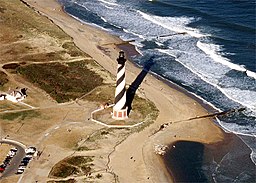Cape Hatteras, North Carolina
| Cape Hatteras | |
|---|---|

An aerial view of the Cape Hatteras Lighthouse prior to its 1999 relocation
|
|
| Location | United States |
| Coordinates | 35°15′16.49″N 75°31′11.82″W / 35.2545806°N 75.5199500°WCoordinates: 35°15′16.49″N 75°31′11.82″W / 35.2545806°N 75.5199500°W |
Cape Hatteras /ˈhætərəs/ is a cape on the coast of North Carolina, and is protected as the namesake feature of the Cape Hatteras National Seashore. It is the point that protrudes the farthest to the southeast along the northeast-to-southwest line of the Atlantic coast of North America.
It is also the nearest landmass to Bermuda, which is about 563 nautical miles (648 mi; 1,043 km) to the east-southeast.
The community of Buxton lies on the inland side of the Cape itself, at the widest part of Hatteras Island. It is the largest community on the island, and is home to the governmental offices and schools for the Island.
Cape Hatteras is a bend in Hatteras Island, one of the long thin barrier islands that make up the Outer Banks. It is the site where the two great basins of the East Coast meet. The cape's shoals are known as Diamond Shoals. Somewhat analogous to Point Conception in Southern California, this on-the-edge placement at the confluence of the Labrador and Florida currents leads to unusually diverse biological assemblages. Many species' ranges have either a southern or northern terminus at the cape.
Cape Hatteras has a humid subtropical climate (Köppen Cfa) and is part of USDA Plant Hardiness Zone 9. It is surrounded by large bodies of water, with Pamlico Sound to the west and northwest, and the Atlantic Ocean to all directions from northeast through southwest. The proximity to water moderates conditions throughout the year, producing cooler summers and warmer winters than inland areas of North Carolina. The warmest days in July and early August have an average high temperature of less than 85 °F (29 °C). As a result of its proximity to water, temperatures above 90 °F (32 °C) are rare, with an average of only 2.3 days per summer above 90 °F (32 °C); one to three years out of each decade will not see any 90 °F readings. The coolest month, January, has a daily mean of 45.5 °F (7.5 °C), with lows normally well above freezing (32 F). The average window for freezing temperatures is from December 12 to March 11 (allowing a growing season of 275 days), between which there is an average of 21 nights with lows at or below the freezing mark, though only once every several years does the thermometer stay at or below the freezing mark all day. Extremes in temperature range from 6 °F (−14 °C) on January 21, 1985 up to 97 °F (36 °C) on June 27, 1952.
...
Wikipedia
